From Lubbock Texas, after the black-out cold storm, scientist Katherine Hayhoe talks record billion dollar climate disasters. Her PBS YouTube series is “Global Weirding”. From Bergen Norway, lead scientist Christoph Heinze warns about three OTHER crisis developing unseen below the seas. His new paper in the Proceedings of the National Academy is ominously titled: “The quiet crossing of ocean tipping points”.
Listen to or download this Radio Ecoshock show in CD Quality (57 MB) or Lo-Fi (14 MB)
Twenty twenty was a brute of a year.
Even as the pandemic crashed economies, extreme weather and natural disasters harried hundreds of millions of people. The American government reported an absolute record number of billion dollar disasters from mega-fires across the West through repeat hurricanes, flooding storms, and just plain strange stuff, like straight-line winds blowing down everything in a path across several states. Our first guest calls it “global weirding” – the title of her PBS YouTube series. Katherine Hayhoe is a climate communicator and a very serious scientist. We talk through the disaster year and behind them all – the new state of climate change. I reached Katherine in Lubbock Texas shortly after the big chill put millions in the dark, including her University Texas Tech.
That’s the news for you land animals. While we tally up the on-going damage and try to carry on, there is another storm brewing deep below the ocean. From Bergen Norway, lead scientist Christoph Heinze warns about three OTHER crisis developing unseen below the seas. His new paper in the Proceedings of the National Academy is ominously titled: “The quiet crossing of ocean tipping points”. The ocean contains a mix of elements, chemicals ,and so many creatures numbers cannot count them. Geophysical forces move it all around in currents that feed everything from plankton to whales. All that is in a state of change as heat and carbon swamp the system. When they shift, nothing can bring them back.
Scroll down to watch the video version of my second guest interview with Christoph Heinze.
======================================================================================================
KATHERINE HAYHOE – BILLION DOLLAR BLACK-OUT DISASTERS
She started observing stars and galaxies. But she became one of America’s better-known atmospheric scientists. Now Dr. Katherine Hayhoe takes us beyond the pandemic to the other disasters of 2020. According to the U.S. Government, 2020 had more billion-dollar-plus extreme weather events than ever before. Yes, underneath the fight-for-life and political drama, climate change is already making life more costly and dangerous for millions of people.
Serving multiple roles at Texas Tech University, we welcome Professor Katherine Hayhoe to Radio Ecoshock. Find her web site here.

Dr. Katherine Hayhoe, Texas Tech
After we chat about the recent extreme weather disaster in Texas, we move on to new reporting from the National Oceanic and Atmospheric Administration about “U.S. Billion-Dollar Weather and Climate Disasters”. There were 22 extreme events that caused over a billion dollars in damages in the United States in 2020, by far the worst ever recorded.
NOAA writes:
“In 2020, there were 22 weather/climate disaster events with losses exceeding $1 billion each to affect the United States. These events included 1 drought event, 13 severe storm events, 7 tropical cyclone events, and 1 wildfire event. Overall, these events resulted in the deaths of 262 people and had significant economic effects on the areas impacted. The 1980–2020 annual average is 7.0 events (CPI-adjusted); the annual average for the most recent 5 years (2016–2020) is 16.2 events (CPI-adjusted).”
For more in-depth analysis, this report offers the latest summary on the 2020 U.S. billion-dollar weather and climate disasters in historical context.
Let’s look at three prime examples of climate-related disasters costing Americans more than $46 billion last year. We could start with the biggest, the $19 billion dollar wrecking Hurricane Laura. It went by in a blur hardly remembered by those outside the storm. Katherine explains Hurricane Laura’s climate links. It’s the usual: a warmer atmosphere holds more water, meaning record-smashing rain. The Gulf of Mexico was unusually hot, although that too is becoming the new normal. Ocean heat powers up hurricanes.
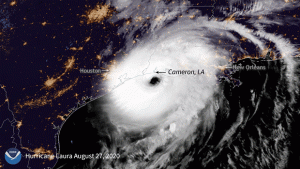
Hurricane Laura (NOAA)
Then an unknown: how much has the drop in difference between Arctic temperatures and the Equator weakened the Jet Stream? That may explain why some 2020 storms were very slow moving, hovering over several states with non-stop rains that flooded everything.
The Western wildfires were record-shattering, absolutely epic in 2020. More than 10 million acres burned from California right up the coastal states. Over 10,000 buildings were lost and 37 people died. The estimated cost of those fires was a staggering $19 billion dollars!
Underlying the 2020 wildfire season in the U.S. was a long-standing drought that dried up not just the soil, but the vegetation into tinderbox state. Extra hot winds fanned the flames. The climate fingerprints are all over those fires.
And then we have the $11 billion disaster other people hardly heard of. It wasn’t a hurricane but a straight-on power wind called a “derecho” blew down $11 billion dollars worth of infrastructure. Until a few years ago, a derecho wasn’t a thing. The August 2020 wind monster that swept through a dozen Mid-West states put the word into everybody’s vocabulary.
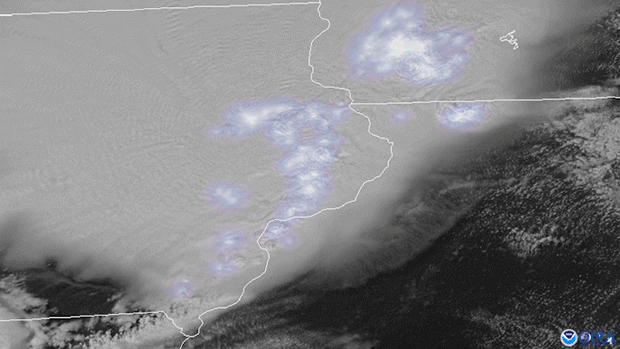
I thought maybe 2020 was just an outlier, a strange weather year that just popped up. But the NOAA report shows billion dollar disasters are increasing decade by decade:
“In particular, the historically large U.S. losses from hurricanes and wildfires over the last four years (2017-2020) have further skewed the total distribution of extreme weather costs. From 1980-2000, about 75% of all disaster-related costs were due to billion-dollar disasters, and by 2010, the percentage had risen to about 80%. By 2020, it had risen again to about 85% of all disaster-related costs, or $1.875 trillion out of $2.215 trillion.”
Has any scientist tried to work out a projection of those trends, so we can envisage the extreme weather after say 2030 or 2050? Funny thing: that is exactly what our guest Katherine Hayhoe is working on next. I wonder if there is a tipping point in most national economies where the continuing damages fueled by climate change become greater than our ability to recover, and to pay the costs. Will humans be pummeled into a lower standard of living?
There has been an ongoing debate about whether there will be more hurricanes and other violent storms as we go forward into climate change, or just stronger storms when they do come. The issue of whether there will be MORE of them is not yet settled. We can’t expect severe weather like 2020 every year. But we may get those punisher years more frequently. But the physics of warming the Earth is clear: those hurricanes and fires that get started will be more extreme.
CLIMATE CHANGE IS NOT FAIR
When we look at the NOAA map of where the most disasters, and the most deadly strike – they are states with a lot of African Americans and Latinos, including undocumented immigrants. Climate change is hurting those groups harder. Do they know the climate connection, and what can be done to ensure disadvantaged people are not pushed further down?
A PEEK AT SOME OTHER HAYHOE WORK…
In 2019 Katherine contributed Chapter 6 to a work on challenges to American infrastructure. In our interview she explains “stationarity”. It turns out most government and corporate planning works the way you do – we think about the past and assume the future will be like that. It’s OK to build a new housing development in a place which has never flooded. Nobody needs to harden an electric grid against sub-zero cold where that has never happened. Now that playbook is out the window, along with the old climate records.
By the way, when NOAA looks at billion dollar disasters, Texas shows up in every category: droughts, heat waves, winter storms, hurricanes, flooding, wildfires – Texas more than any other state gets them all.
Last week we talked with Didi Pershouse about soil strategies during climate change. Katherine did a presentation on that and we discuss that key relationship briefly in this interview.
Katherine Hayhoe, is a Renaissance woman really. Along with over a decade of published scientific work, and all her outreach to other organizations both scientific and activist, she has her own PBS YouTube show. “Global Weirding: Climate, Politics and Religion” runs from October to March every year. I ask Katherine about the new book she is working on.
KEEPING THE FAITH
Dr. Hayhoe’s husband is a Pastor with a Christian radio program on Sirius XM (Andrew Farley). Some people struggle to keep both faith and science. Katherine offers us tips for people who struggle with that. She and Andrew wrote the book “A Climate for Change: Global Warming Facts for Faith-Based Decisions”.
Katherine does a lot of statistical and very technical work. She might have been a quiet geek, but instead chose what I call the Stephen Schneider role of climate communicator. America and the world are lucky to have her voice reaching into publics that need to hear it.
======================================================================================================
3 QUIET TIPPING POINTS IN THE OCEAN – CHRISTOPH HEINZE
We continue to dump greenhouse gases into the atmosphere from our vehicle tailpipes, home chimneys and factory smokestacks. Pandemic or no, we load up the atmosphere daily. About 90% of our carbon waste is helpfully captured by the oceans, mixing down into the great deep. There is a terrible price though. The sea becomes more acidic and oxygen gives way to dead zones increasing around the globe. Even the formation of clouds is endangered.
To get the goods, we go to a University lab in northern Norway. Professor Christoph Heinze runs large scale projects for the European Union among others. He patrols the sea looking for the “quiet crossing of ocean tipping points.” From Bergen, Dr. Heinze shares his work and his worry for us, and for the long-term future of Earth as host to life itself.

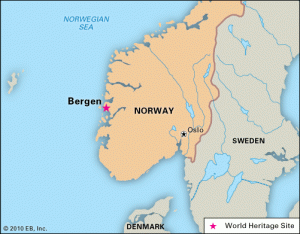
Dr. Christoph Heinze, Bergen
3 HIDDEN TIPPING POINTS – CHRISTOPH HEINZE ON VIDEO
Our main focus is a paper just published by PNAS March 2021 and led by Dr. Heinze: “The quiet crossing of ocean tipping points”. But building toward that point, we begin with his 2018 paper on a kind of switch in the ocean which reduces the amount of oxygen vital for life.
Oxygen in the ocean could become depleted as climate change develops
Popularly known as “dead zones”, marine oxygen depletion is popping up in many parts of the world. Obviously most of the ocean still has lots of life. Do regional oxygen depletion zones really matter in the global picture? This is a key point in Christoph’s science: a global picture misses out on the total impacts of many separate “regional” events. But they do add up in many important ways.
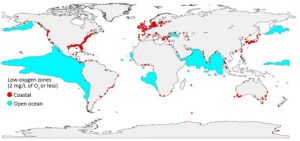
Ocean dead zones
Heinze raises the problem of gradual changes which add up to extreme impacts over time. Humans tend to focus on a chain of big events while ignore creeping change. It is like a flaw in our perception. We find this in the Abstract for the 2021 paper:
“High-probability high-impact ocean tipping points due to warming, ocean acidification, and deoxygenation may be more fragmented both regionally and in time but add up to global dimensions. These tipping points in combination with gradual changes need to be addressed as seriously as singular catastrophic events in order to prevent the cumulative and often compounding negative societal and Earth system impacts.”
The worry about regional damages adding up to global dimensions applies to land as well as sea, I think.
ACIDIFICATION
As another dark side to fossil fuel pollution, the ocean is becoming measurably more acidic. That is bad news for ocean life. How well are we monitoring that chemical side of climate change? Quite well, Christoph reports. Are there “tipping points” lurking in ocean acidification or it’s impacts on living things? I’m still not clear whether acidification is one of those key creeping changes, or where to expect a noticeable event, like a year when plankton dies off in great numbers.
NATURAL MARINE SULFATES
In 2017 Heinze co-authored a paper about an “amplification of global warming” by a process seldom discussed outside specialty science. This is marine dimethyl sulfide (DMS). Marine life cycles sulfur, creating tiny particulates (aerosols) which float up into the atmosphere. Those natural sulfates are one of the primary sources for nuclei attracting enough water vapor to form clouds. Changes to the cycle of DMS with warming seas could interfere with the process of making clouds. I wonder if that too will be an important regional effect.
Another paper in PNAS, published March 3, 2020 by P.R. Veres et al shows the climate importance of natural DMS:
“Dimethyl sulfide (DMS) has been the subject of a decades-long research effort due to its role as the major natural global sulfur emission. DMS oxidation across the world’s ocean basins is thought to produce sulfate aerosol, which in turn alters Earth’s albedo and climate. “
So this is wild. We hear calls for geoengineering, for last-ditch climate control, by blasting sulfates into the atmosphere as a sun shade. But natural sulfur emissions from the oceans may be reduced by climate change at the same time.
BEYOND WARMING: THE OTHER TIPPING POINTS
Most of my expert interviews on the ocean concentrate on the growing impacts of heat in the sea. It could be warm waters gnawing under ice sheets, killing coral, and powering up hurricanes or cyclones. But you just raised three OTHER ocean feedbacks: oxygen depletion, acidification, and natural sulfur emissions. Christoph warns these unseen tipping points may arrive before the worst ocean heating. These may be the early signals of major shifts in world oceans.
According to Heinze, none of these biochemical changes in a vast ocean can be limited or reversed by any known process available to humanity. There is no plan B for loss of oxygen, acidification, or marine sulfates – except to stop pushing these across “quiet tipping points” with continuing greenhouse gas emissions.
DURING THE INTERVIEW Christoph cites the IPCC Special Report on the Ocean and Cryosphere in a a Changing Climate. This report contains a good discussion on tipping points and reversibility. It also has a Table showing abrupt tipping points in the ocean and cryosphere. Download the full .pdf report (free) here.
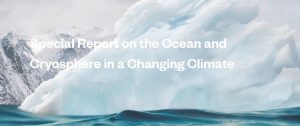

Christoph also mentions his role with the “Comfort Project” funded by the EU. The official URL for that project was not working the day I tried it. (comfort.w.uib.no) This one works. The Comfort Project is described as “An integrative projection model towards ocean sustainability”.
======================================================================================================
THE U.N. SAYS WE ARE RUNNING OUT OF TIME
The United Nations climate framework calls for all countries who signed the 2015 Paris Accord to submit their plans for reducing greenhouse gases. The deadline was set for the end of 2021, so only 9 months remain. Otherwise, the UN says, there is no way to keep global warming to a safer 1.5 degrees C, and 2 degrees C seems locked in by the end of this century. Many of my scientific guests consider that whole discussion is far too optimistic. With concerted action, we might say under 3 degrees of warming of preindustrial times by 2100. That means it is already time for emergency damage control. We are heading over the climate cliff.
NEXT WEEK: HOW TO DEAL WITH CLIMATE STRESS
So many people who know the awful truth about climate change are experiencing stress. Some give up and can’t even bear to hear about it anymore. Tell them about next week’s Radio Ecoshock show. The highly respected UK psychologist Ro Randall just gave a webinar on how to handle the stress of climate knowledge, and the extreme events as they come. We had Rosemary on the show in 2015 telling us how to talk with a climate denier. Now she has some comfort and tools to help us cope with climate change. We will go to the full seminar. It helped me. Tune in next week for this special program.
On Radio Ecoshock you just get pure science and voices that love this planet. This is my mission in life, to get lead voices out to you, understanding the planet in their works and words. Please feel free to pass around these interviews, re tweet our show (Follow Radio Ecoshock on Twitter @ecoshock), Face book it, subscribe to the show channel on YouTube, the works. If you can afford to help me produce and distribute this program (free to all stations and listeners around the world) – please give what you can here.
Thank you for listening, and caring about our world.
Pingback: Fukushima anniversary week – nuclear news | Nuclear Australia